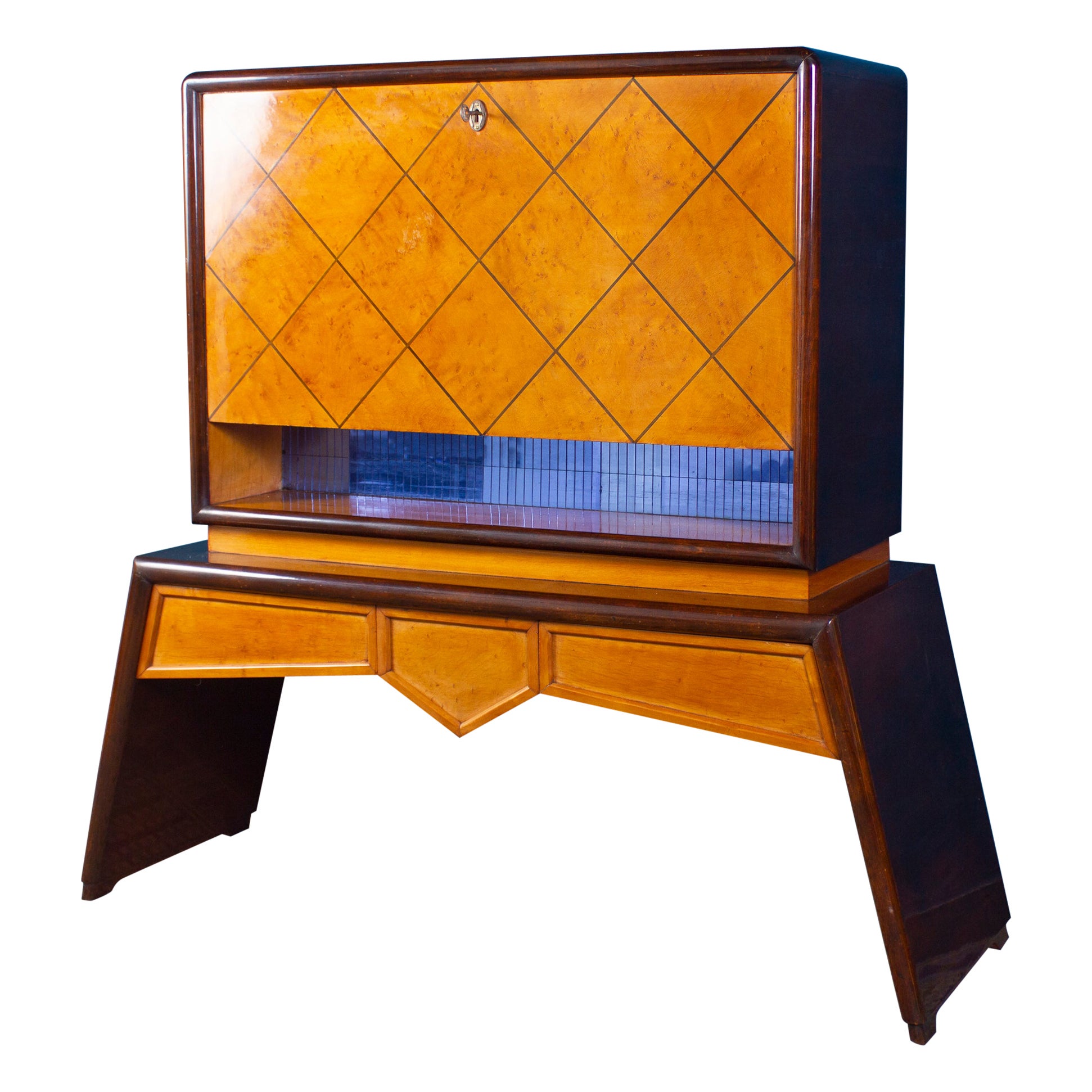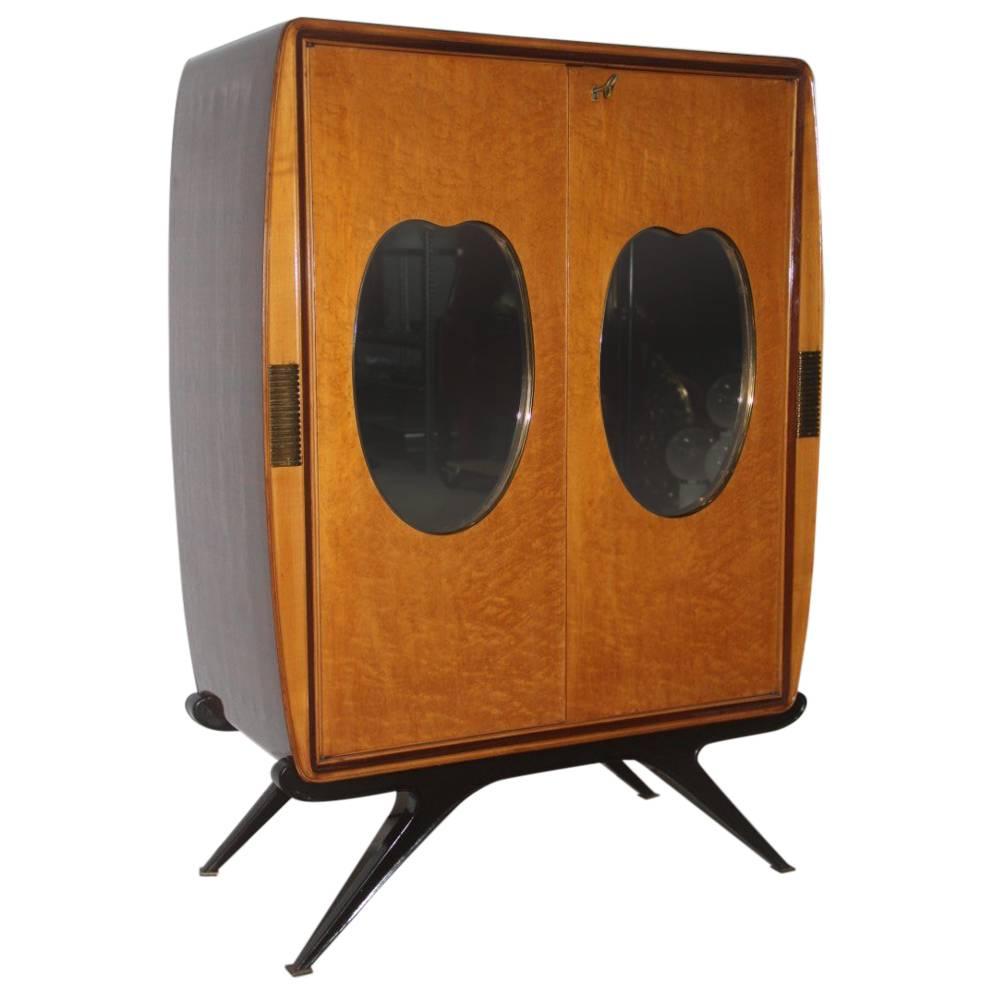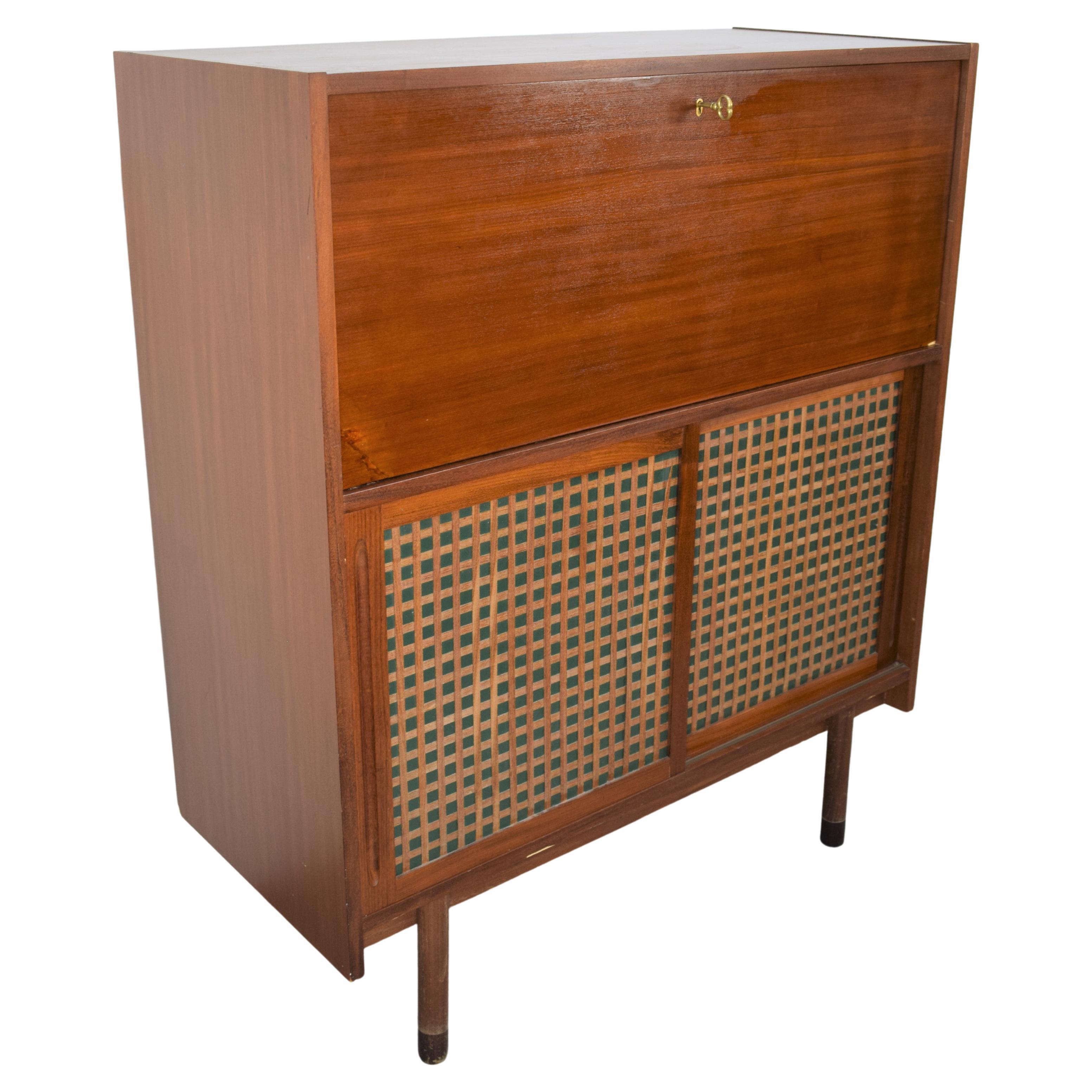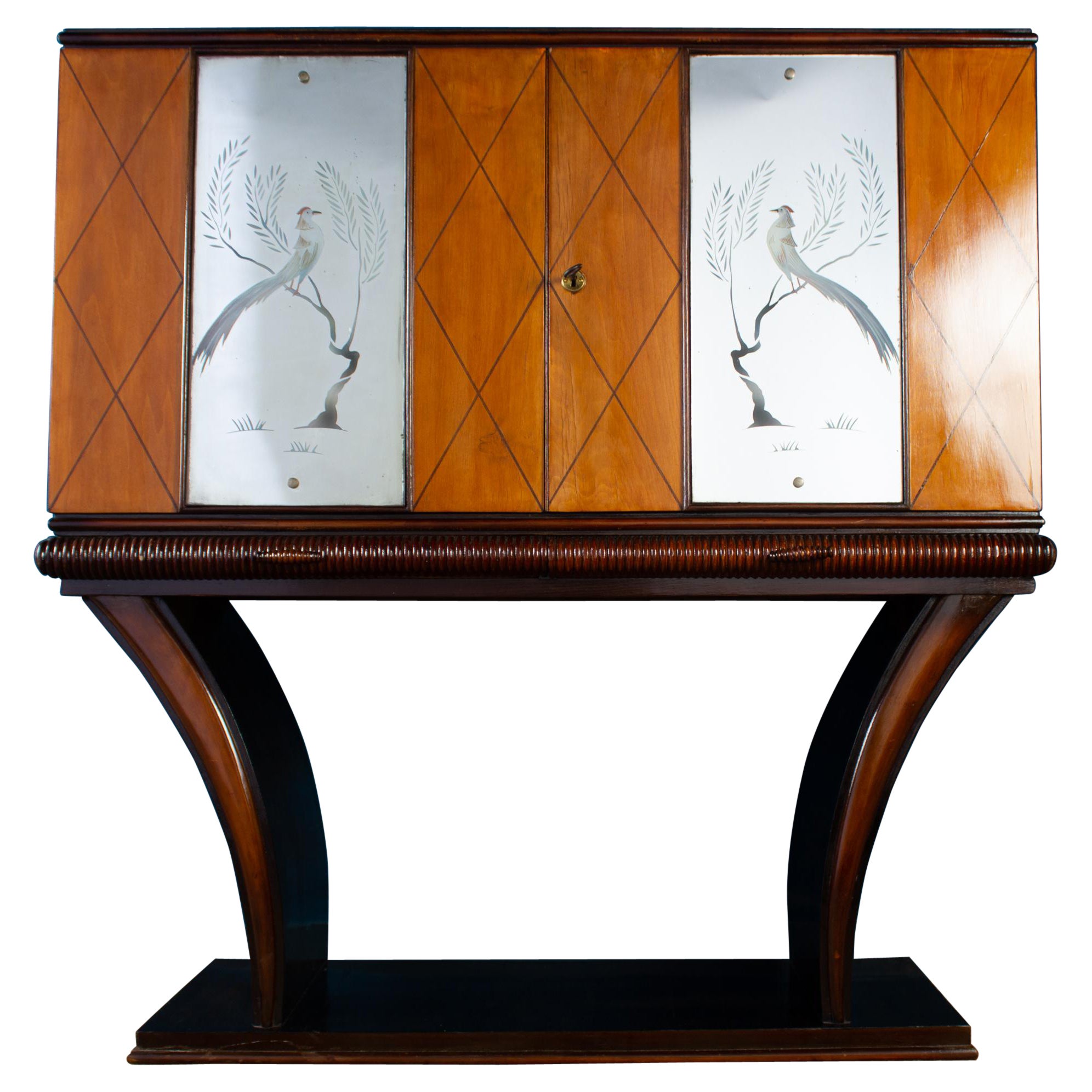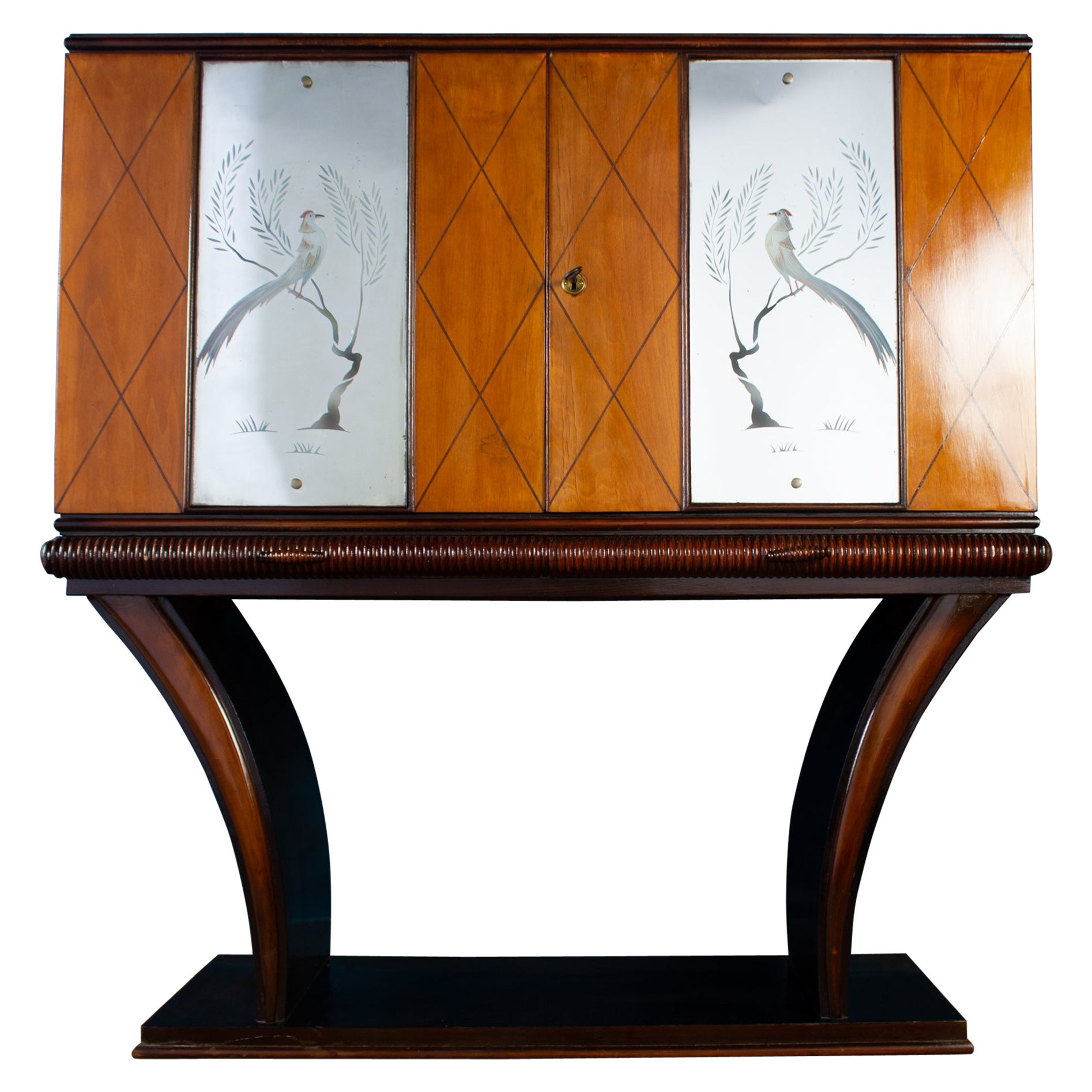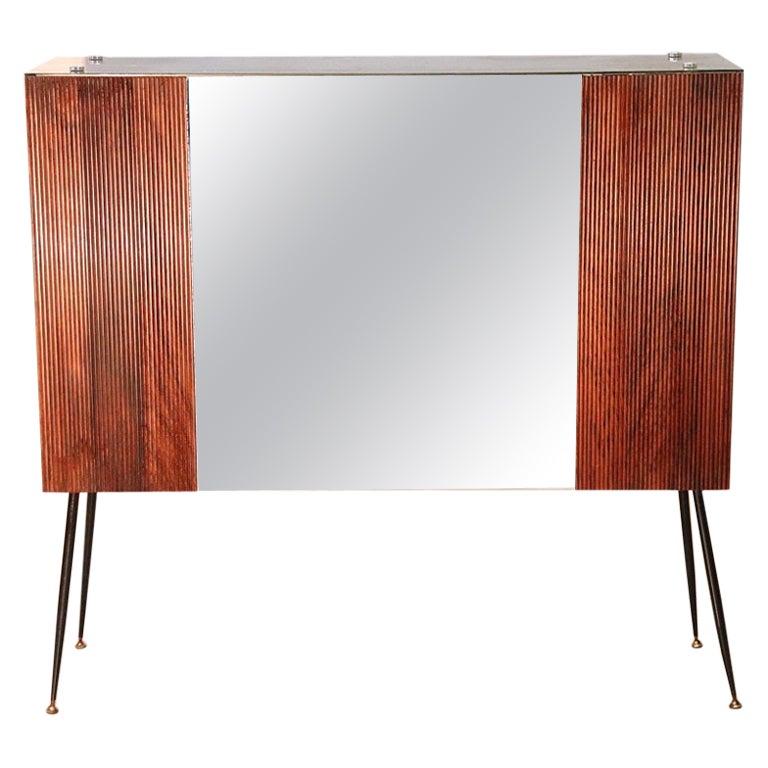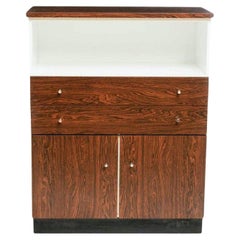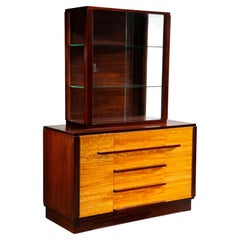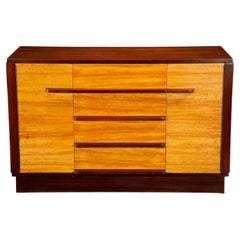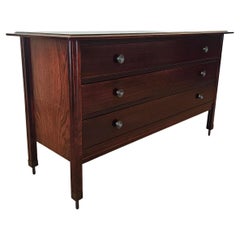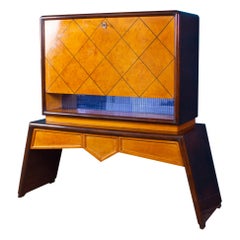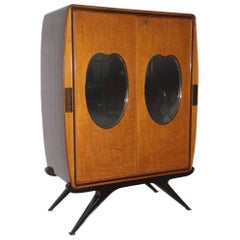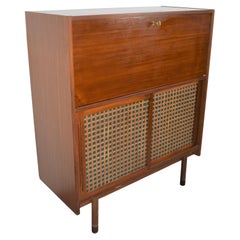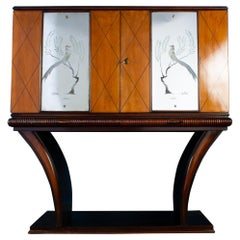Items Similar to Osvaldo Borsani Mid-Century Modern Italian Bar Cabinet
Want more images or videos?
Request additional images or videos from the seller
1 of 7
Osvaldo Borsani Mid-Century Modern Italian Bar Cabinet
$12,500
£9,491.55
€10,854.29
CA$17,464.31
A$19,424.13
CHF 10,142.68
MX$236,370.98
NOK 129,537.45
SEK 121,483.28
DKK 81,009.74
Shipping
Retrieving quote...The 1stDibs Promise:
Authenticity Guarantee,
Money-Back Guarantee,
24-Hour Cancellation
About the Item
Make a statement with this rare mid-century Italian modernist bar cabinet (sideboard buffet) attributed to legendary designer Osvaldo Borsani (Italy, 1911-1985), circa 1950s.
Having a swan's neck pediment, glazed glass doors, interior mounted with artistic hand painted panel, two glass shelves, lower case with drop-front secretary desk style slant-front bar work surface, over double-door cabinet, rising on ebonized curved legs.
**Please note, at the time of writing this, we have a matching table available separately**
DIMENSIONS: (approx)
92.5" High, 35.5" Wide, 17.5" Deep
ABOUT OSVALDO BORSANI:
Osvaldo Borsani (born 1911, Varedo, Italy–died 1985, Milano, Italy) was an Italian designer and architect. Osvaldo Borsani was born into a family of artisan furniture makers. His father, Gaetano Borsani, owned a furniture shop, the Atelier di Varedo, where the 16-year-old Osvaldo first started to train. At the time, a designer working at the atelier was the architect Gino Maggioni, who influenced the early 20th century Jugendstil movement from Vienna and instilled in the young Borsani an appreciation for the arts and crafts and furniture making.
Osvaldo Borsani studied Fine Arts at the Accademia di Belle Arti di Brera in Milan, graduating in 1931, he then studied Architecture at Politecnico di Milano, where he graduated in 1936.
In 1933, two years before graduating as an architect, Borsani designed the Casa Minima project for the V Triennale di Milano (Milan Triennial), collaborating with Cairoli and Varisco's architects. This project earned him a silver medal for its Rationalist code and geometries, and he received positive reviews from the critic Edoardo Persico of Casabella magazine.
In 1937, Osvaldo Borsani designed Villa Presenti in Forte dei Marmi, a seaside home in Tuscany where the Italian aristocracy and industrial elite often built their houses. It was a project that displayed the same rationalistic rigor as Casa Minima, but was softened with Mediterranean colors and materials.
In 1943, Osvaldo designed and built his own house, the Villa Borsani, in Varedo, which, despite being conceptualized with strict Rationalist principles, assimilated objects and art of younger artists that conversed a more gentle approach to the human expression. The Villa Borsani project incorporated the work of artists such as Adriano Spilimbergo, Fausto Melotti, Lucio Fontana (who made the ceramic fireplace and the ceramic Madonna), and Agenore Fabbri (who made the bronze statue in the staircase). To this day, Villa Borsani has been preserved with most of its original furniture, and it remains in the hand of Osvaldo Borsani's family, along with extensive archives of his work.
After Villa Borsani, Osvaldo continued to develop many projects for the Milanese bourgeoisie, always incorporating the same artist's work. He developed a particularly strong relationship with artist Lucio Fontana, a close friend since his time at the Accademia de Belle Arti di Brera. Borsani assigned Fontana to make a large balcony for the Tecno company in 1956.
Like his architectural projects, Osvaldo Borsani's design work often drew inspiration from artists and designers such as Roberto Crippa, Arnaldo and Giò Pomodoro, Agenore Fabbri, Fausto Melotti, Andrea Cascella, and Lucio Fontana. Borsani's collaboration with Lucio Fontana resulted in many of Borsani's furniture designs in the late 1930s and 1940s. With Fontana, Borsani integrated sculptural ceramic and bronze elements, wood and gilded stucco, and interventions on glass tabletops with decorations, to name a few design elements, to his furniture designs.
In 1953, Osvaldo understood the imminent need to transform the artisan approach to furniture into a modern industry capable of meeting increasing demands at more accessible prices. It was then that Osvaldo and his twin brother Fulgenzio founded the manufacturer Tecno to incorporate modern manufacturing techniques that would deliver high-quality furniture to a larger international market. Initially, Tecno manufactured only Borsani's furniture designs, and the company continued to design furniture and objects until the early 1980s. However, in the late 1950s, Tecno also manufactured furniture from other designers, including Vico Magistretti, Roberto Mango, Gae Aulenti, Eugenio Gerli, Carlo de Carli, and Gio Ponti.
Among the most successful and iconic Tecno designs are the 1954 D70, a sofa that can be used in approximately 20 positions; the 1955 P40 adjustable chair, described as a "machine for sitting," which could assume 486 distinct postures; the 1954 T41 dining table; the 1961 AT 16 coat rack; the 1965 Canada chair; the 1968 Graphis office furniture system; and the 1972 P128 office chair.
Along with Eugenio Gerli, Marco Fantoni, his brother Flugenzio, and his daughter Valeria, Osvaldo Borsani founded Centro Progetti Tecno (1970), a design shop focused on creating innovative products and interiors for work and school environments.
Early furniture pieces by Tecno can be found in the permanent collections of the MoMA in New York, the Victoria & Albert Museum in London, the Centre Pompidou in Paris, the Trienalle di Milano Museum, and the Neue Sammlung in Munich.
In 2018, the Triennale di Milano organized a retrospective of Osvaldo Borsani’s work. The exhibition "Osvaldo Borsani" was co-curated by Tommaso Fantoni, Borsani's grandson, and Norman Foster. They had worked with Borsani at Tecno, where he designed the Nomos table and furniture systems for airport and museums.
PROVENANCE / ACQUISITION:
Acquired from highly reputable auction house, Austin Auction Gallery, est.1983, Austin, TX. Exceptional October Estates Auction catalog
CONDITION:
Great original vintage condition. Presents well. Desirable unrestored example. May have minor wear consistent with 70 years of age and use. Delivered cleaned, waxed, with hand rubbed polished French patina finish, ready for immediate use and generational enjoyment!
PICKUP IN DALLAS, TEXAS
WORLDWIDE SHIPPING AVAILABLE
- Attributed to:Osvaldo Borsani (Designer)
- Dimensions:Height: 92.5 in (234.95 cm)Width: 35.5 in (90.17 cm)Depth: 17.5 in (44.45 cm)
- Style:Mid-Century Modern (In the Style Of)
- Materials and Techniques:
- Place of Origin:
- Period:
- Date of Manufacture:circa 1950s
- Condition:Wear consistent with age and use. Great original vintage condition. Presents well. Desirable unrestored example. May have minor wear consistent with age and use. Delivered cleaned, waxed, with hand rubbed polished French patina finish, ready for immediate use & generational enjoyment.
- Seller Location:Forney, TX
- Reference Number:1stDibs: LU5977234012872
About the Seller
4.8
Platinum Seller
Premium sellers with a 4.7+ rating and 24-hour response times
Established in 2013
1stDibs seller since 2021
294 sales on 1stDibs
Typical response time: <1 hour
- ShippingRetrieving quote...Shipping from: Forney, TX
- Return Policy
Authenticity Guarantee
In the unlikely event there’s an issue with an item’s authenticity, contact us within 1 year for a full refund. DetailsMoney-Back Guarantee
If your item is not as described, is damaged in transit, or does not arrive, contact us within 7 days for a full refund. Details24-Hour Cancellation
You have a 24-hour grace period in which to reconsider your purchase, with no questions asked.Vetted Professional Sellers
Our world-class sellers must adhere to strict standards for service and quality, maintaining the integrity of our listings.Price-Match Guarantee
If you find that a seller listed the same item for a lower price elsewhere, we’ll match it.Trusted Global Delivery
Our best-in-class carrier network provides specialized shipping options worldwide, including custom delivery.More From This Seller
View AllMid-Century Deco Modern Formica Rosewood Cabinet
Located in Forney, TX
An impressive, very good quality mid-century cabinet, Art Deco Moderne taste, finished in stunning rosewood with white formica. Two cupboard doors open to spacious interior fitted wi...
Category
Mid-20th Century Mid-Century Modern Cabinets
Materials
Formica, Rosewood
Art Deco Signed Wolfgang Hoffmann for Romweber World's Fair Display Cabinet
By Wolfgang Hoffmann, Romweber Furniture Co.
Located in Forney, TX
A rare and important Art Deco period Century of Progress Display Cabinet designed by Wolfgang Hoffmann (Austrian, 1900-1969) for Romweber Company, Batesville, Indiana, United States of America. circa 1933-1936
Created for the 1933 Chicago World's Fair, one piece design, having a rectangular showcase top with glass panel sides and a pair of sliding glass doors, over solid wood chest fitted with four drawers affixed with horizontal pulls, flanked by cabinet doors, opening to shelved interior. Rosewood, mahogany, richly figured blonde - golden birch or primavera, and glass.
Signed, original label to drawer interior, featuring 1933 World's Fair mark impressed.
**Please note, at the time of writing this, a matching sideboard - buffet (shown in last photo) is currently available separately**
Provenance / Acquisition:
Property from the important and iconic collection of Mr. James I. Rafftesaeth Jr., Dallas, Texas
Acquired from highly reputable auction house, Heritage Auctions, Dallas, Texas. 2022 Design Signature Auction catalog #8091
History:
Wolfgang Hoffmann was born in Vienna, Austria in 1900. He is the son of famous architect, pedagogue and Wiener Werkstatte cofounder, Joseph Hoffmann (1870-1956). Early on, following his father’s s interests, he was trained in the decorative arts and design. Wolfgang Hoffmann once reminisced, “I spent eight years at the Realschule, then three years went to a special architectural school, where I perfected my technical knowledge of architecture and general construction. From this school, I was graduated to the Kunstgewerbeschule [Studying under Oskar Strnad and Josef Frank in Vienna]. After finishing this school, I had one and a half years of practical in a well known architect’s office. Thereafter I worked in my Father’s office for two years”.
Hoffmann met his future wife, Polish immigrant Pola (1902-1984) when they were both studying at the Kunstgewerbeschule. Joseph Urban (1872-1933) was needing an assistant for his architectural business in New York and contacted his friend and colleague, Joseph Hoffmann in Vienna. Hoffmann recommended his son Wolfgang. Urban hired him and sent a first class passage ticket to Vienna for Wolfgang to travel to New York. Wolfgang married Pola and traded his ticket for two tickets to America in steerage, arriving in New York City in December of 1925.
Leaving the Urban office after nine months, Wolfgang and Pola formed an independent design practice with offices on Madison Avenue in Manhattan with the purpose of creating contemporary interiors and industrial designs. Early work included theaters, stores, and apartments mostly in New York City.
During the late 1920’s and early 1930’s the Hoffmanns designed custom furniture for private clients. Some of these examples were shown in the February 1929 issue of House and Garden. Curiously, the examples’ design was attributed to Urban and the production to Pola Hoffmann, Inc.
Established in the fall of 1928, the American Designers’ Gallery was “devoted exclusively to showing objects and interiors for practical use… by fourteen American architects and designers”. Its members included the Hoffmans and Urban as well as ceramist Henry Varnum Poor (1888-1971), architect Raymond Hood (1881-1934), artist designer Winold Reiss (1886-1953), graphic designer Lucien Bernhard (1896-1981), decorator Donald Deskey (1894-1989), and architect Ely Jacques Kahn (1884-1972).
The Hoffmanns’ work was included in the American Designers’ Gallery’s two showcase events, its 1928 and 1929 exhibitions. Their dining alcove at the 1929 event featured a bench with a dinette table and two chairs in American walnut designed by Wolfgang and a rug by Pola.
Lucien Bernhard, fellow Austrian immigrant who settled in New York a year before the Hoffmanns, operated the gallery and decorating service Contempora with Munich resident Bruno Paul (1874-1968). The Hoffmanns, occasionally participating with Contempora, designed a number of outstanding interiors, including the constructivist living room of 1930 for Mrs. O.R. Sommerich at 40 East 66th street. In 1934, Donald Deskey commissioned Wolfgang to design birchwood furnishings for the eclectic apartment at 625 Park Avenue belonging to Helena Rubinstein.
In 1931, Wolfgang exhibited his work at the Pennsylvania Art Museum and the Museum of Modern Art in New York City. The same year, with Kem Weber (1889-1963) he organized the second and final exhibition of AUDAC- “Modern Industrial and Decorative Arts”- at the Brooklyn Museum. At this event, the Hoffmanns showed the dining room previously included in the American Designer’s Gallery’s 1929 exhibition in the Chase Bank Building lobby at 145 West 57th Street in Manhattan.
In 1932 Wolfgang was asked to assist Urban in developing the color scheme for the 1933-34 Chicago World’s Fair “A Century of Progress”. He was also commissioned to design the interior and furniture for the fair’s lumber industries house. There he executed its living and dining rooms furnished by Kroehler Manufacturing Company of Chicago; the boys’ room by Shower Brothers...
Category
Early 20th Century American Art Deco Vitrines
Materials
Glass, Mahogany, Rosewood
Art Deco Wolfgang Hoffmann Romweber World's Fair Century of Progress Sideboard
By Wolfgang Hoffmann, Romweber Furniture Co.
Located in Forney, TX
A rare and important American Art Deco Century of Progress Sideboard by iconic designer Wolfgang Hoffmann (Austrian, 1900-1969) for Romweber Company, Batesville, Indiana. circa 1933-1936
Created for the 1933 Chicago World's Fair, fine quality craftsmanship and construction, having a rectangular exotic rosewood veneered top over conforming solid wood case fitted with four drawers affixed with horizontal pulls, the top drawer opening to reveal felt lined divided interior for silverware, flanked by cabinet doors opening to shelved interior, subtle geometric lines add interest. Rosewood, mahogany, richly figured blonde - golden birch or primavera.
Signed, top drawer interior, featuring 1933 World's Fair mark impressed.
**Please note, at the time of writing this, a matching display case - vitrine cabinet (shown in last photo) is currently available separately**
Provenance / Acquisition:
Property from the important and iconic Collection of Mr. James I. Rafftesaeth Jr., Dallas, Texas
Acquired from highly reputable auction house, Heritage Auctions, Dallas, Texas. 2022 Design Signature Auction catalog #8091
History:
Wolfgang Hoffmann was born in Vienna, Austria in 1900. He is the son of famous architect, pedagogue and Wiener Werkstatte cofounder, Joseph Hoffmann (1870-1956). Early on, following his father’s s interests, he was trained in the decorative arts and design. Wolfgang Hoffmann once reminisced, “I spent eight years at the Realschule, then three years went to a special architectural school, where I perfected my technical knowledge of architecture and general construction. From this school, I was graduated to the Kunstgewerbeschule [Studying under Oskar Strnad and Josef Frank in Vienna]. After finishing this school, I had one and a half years of practical in a well known architect’s office. Thereafter I worked in my Father’s office for two years”.
Hoffmann met his future wife, Polish immigrant Pola (1902-1984) when they were both studying at the Kunstgewerbeschule. Joseph Urban (1872-1933) was needing an assistant for his architectural business in New York and contacted his friend and colleague, Joseph Hoffmann in Vienna. Hoffmann recommended his son Wolfgang. Urban hired him and sent a first class passage ticket to Vienna for Wolfgang to travel to New York. Wolfgang married Pola and traded his ticket for two tickets to America in steerage, arriving in New York City in December of 1925.
Leaving the Urban office after nine months, Wolfgang and Pola formed an independent design practice with offices on Madison Avenue in Manhattan with the purpose of creating contemporary interiors and industrial designs. Early work included theaters, stores, and apartments mostly in New York City.
During the late 1920’s and early 1930’s the Hoffmanns designed custom furniture for private clients. Some of these examples were shown in the February 1929 issue of House and Garden. Curiously, the examples’ design was attributed to Urban and the production to Pola Hoffmann, Inc.
Established in the fall of 1928, the American Designers’ Gallery was “devoted exclusively to showing objects and interiors for practical use… by fourteen American architects and designers”. Its members included the Hoffmans and Urban as well as ceramist Henry Varnum Poor (1888-1971), architect Raymond Hood (1881-1934), artist designer Winold Reiss (1886-1953), graphic designer Lucien Bernhard (1896-1981), decorator Donald Deskey (1894-1989), and architect Ely Jacques Kahn (1884-1972).
The Hoffmanns’ work was included in the American Designers’ Gallery’s two showcase events, its 1928 and 1929 exhibitions. Their dining alcove at the 1929 event featured a bench with a dinette table and two chairs in American walnut designed by Wolfgang and a rug by Pola.
Lucien Bernhard, fellow Austrian immigrant who settled in New York a year before the Hoffmanns, operated the gallery and decorating service Contempora with Munich resident Bruno Paul (1874-1968). The Hoffmanns, occasionally participating with Contempora, designed a number of outstanding interiors, including the constructivist living room of 1930 for Mrs. O.R. Sommerich at 40 East 66th street. In 1934, Donald Deskey commissioned Wolfgang to design birchwood furnishings for the eclectic apartment at 625 Park Avenue belonging to Helena Rubinstein.
In 1931, Wolfgang exhibited his work at the Pennsylvania Art Museum and the Museum of Modern Art in New York City. The same year, with Kem Weber (1889-1963) he organized the second and final exhibition of AUDAC- “Modern Industrial and Decorative Arts”- at the Brooklyn Museum. At this event, the Hoffmanns showed the dining room previously included in the American Designer’s Gallery’s 1929 exhibition in the Chase Bank Building lobby at 145 West 57th Street in Manhattan.
In 1932 Wolfgang was asked to assist Urban in developing the color scheme for the 1933-34 Chicago World’s Fair “A Century of Progress”. He was also commissioned to design the interior and furniture for the fair’s lumber industries house. There he executed its living and dining rooms furnished by Kroehler Manufacturing Company of Chicago; the boys’ room by Shower Brothers...
Category
Early 20th Century American Art Deco Sideboards
Materials
Birch, Mahogany, Rosewood
Midcentury Modern Era Designer Carlo De Carli Sormani Rosewood Chest of Drawers
By Carlo De Carli, Sormani
Located in Forney, TX
A fine quality Italian modern chest of drawers designed by famed architect and designer Carlo de Carli (Milan, Italy; 1910-1999) for luxury furniture maker Sormani, model D154, circa...
Category
Mid-20th Century Italian Mid-Century Modern Commodes and Chests of Drawers
Materials
Bronze
Early 20th Century Italian Baroque Marquetry Inlaid Corner Cabinet
Located in Forney, TX
An Italian walnut corner cabinet, molded cornice, over triangular case, upper and lower cupboard doors with contrasting marquetry panels, opening to reveal shelved interior, rising o...
Category
Early 20th Century Baroque Corner Cupboards
Materials
Walnut
Biedermeier Period Burlwood Table Cabinet Of Curiosities Wunderkammer 19th C.
Located in Forney, TX
A fine Biedermeier Period (1815-1848) walnut maple burlwood marquetry table cabinet - wunderkammer (cabinet of curiosities) with fifteen drawers and concealed secret compartments, circa 1820.
This architectural curiosity cabinet is a testament to the ingenuity and artistry of European craftsmen from the early 19th century. The highly figured quilted wood grain, warm rich burled walnut panels, and hand sculpted and molded ebonized wood exterior boasts a dark, lustrous sheen, while delicate hand carved details adorn its surface, showcasing the finesse and precision of its creator.
Probably Southern Germany, most likely Augsburg, having a rectangular raised top with visible hand cut dovetail joint case housing a single drawer, over exquisite stepped moulded ebony transition into large double door cabinet with the original hand forged iron hardware, opening to reveal an interior fitted with eleven drawers surrounding a single locking cupboard door, unlocking to reveal a stunning eight-pointed star marquetry inlaid spring loaded niche panel with hidden release, when triggered the niche slides out to reveal a trio of hidden storage compartments, including a deep bin and two small hidden drawers for the owners most precious valuables. Rising on shaped ebonized wood molding, over a distinctive masculine scalloped skirt, resting on ball feet.
Every inch of this remarkable antique cabinet reflects the warmth and depth of European craftsmanship during the early 19th century — a period celebrated for its quality, superior craftsmanship, comfort, and viewpoint furniture was meant to be publicly displayed. The intricate detailing, exotic and expensive materials, ingenuity and artistry transport you to a time of sophisticated elegance and refinement.
Place this exceptional cabinet in a distinguished office or collectors study, an opulent living room, as a monumental jewelry...
Category
Antique Early 19th Century German Biedermeier Apothecary Cabinets
Materials
Iron
You May Also Like
Amazing Mid-Century Italian Bar Cabinet 1940' Attributed to Osvaldo Borsani
By Osvaldo Borsani
Located in Rome, IT
Elegant and unusual bar cabinet.
Decorated front door with geometrical inlaid. Door panels inside with mosaic mirror and brass and glass shelfs. Support w...
Category
Mid-20th Century Italian Mid-Century Modern Dry Bars
Materials
Wood
Small Rare Mid-Century Cabinet Bar Osvaldo Borsani Italian Design
By Osvaldo Borsani
Located in Palermo, Sicily
Rare particular cabinet, Attibuted Osvaldo Borsani design, in fine wood, interior shaped mirrors, brass parts.
Category
Vintage 1940s Italian Mid-Century Modern Cabinets
Materials
Brass
$3,834 Sale Price
41% Off
Italian Bar Cabinet, 1970s
Located in Palermo, PA
Italian bar cabinet, 1970s.
Dimensions: H= 122 cm; W= 104 cm; D= 45 cm.
Category
Vintage 1970s Italian Mid-Century Modern Cabinets
Materials
Teak
Mid-Century Italian Bar Cabinet 1950' Attributed to Osvaldo Borsani
By Osvaldo Borsani
Located in Rome, IT
Elegant and unusual bar cabinet.
Decorated front door with finely engraved bird figures. Door panels inside with mosaic mirror and brass and glass shelfs....
Category
Mid-20th Century Italian Mid-Century Modern Dry Bars
Materials
Wood
Mid-Century Italian Bar Cabinet 1950' Osvaldo Borsani style
By Osvaldo Borsani
Located in Rome, IT
Elegant and unusual bar cabinet.
Decorated front door with finely engraved bird figures. Door panels inside with mosaic mirror and brass and glass shelfs. Support with two pull-out d...
Category
Mid-20th Century Italian Mid-Century Modern Dry Bars
Materials
Wood
20th Century Italian Design Central Bar Cabinet, 1950s / 1960s
Located in Casale Monferrato, IT
Beautiful and rare Italian design bar cabinet 1960s. Made of fine wood. This rare bar cabinet was made to be placed in the center of the room. On the front it is only decorative with...
Category
Vintage 1960s Italian Mid-Century Modern Dry Bars
Materials
Teak
$4,792 Sale Price
20% Off
More Ways To Browse
Paris Mid Century Modern
Vintage Silver Bars
Italian Mid Century Artists
Vintage Italian Bars
Vintage Bar Chairs
Modern House Bar
Midcentury High Cabinet
Mid Century Modern Canadian
Mid Century Modern Italian Storage Cabinets
Italian Bar Large
Mid Century Auction
Vintage Curved Bars
Curved Bar Mid Century
Italian Medal
Medal Italy
1950s Home Bar
Table With Dry Bar
Used Bar Table And Chairs
